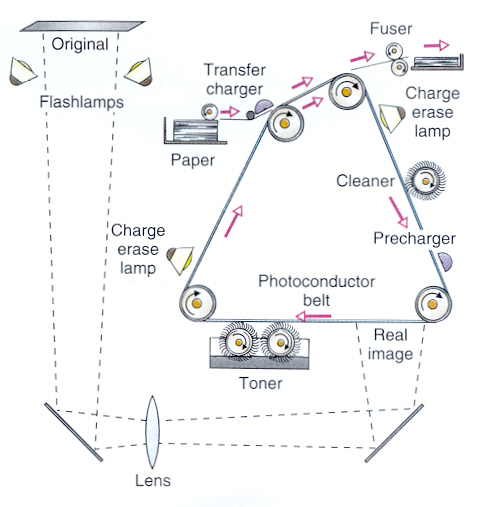
|
| The internal components in a photocopier [ii]. |

Science explains many phenomena and the ways that the things work. By the scientific theories and the nature of matters, they bring a lot of changes in our lives and raise our standard of living. For example, scientists invented many useful tools in medical field that are valuable of diagnosing and treating illness and injury. The invention of magnetically levitated trains and optical fiber reduces the distance between peoples. Photocopier, inkjet printer, fax machine and scanner enhance the efficiency of business operations. In this chapter, we will discuss the physics behind these tools or apparatus.
Photocopier |
|---|
The belt (drum) inside the photocopier is made of
photoconductor which control the placement of
static electricity.

|
| The internal components in a photocopier [ii]. |
In order
to make a copy of the original paper, place it over the glass surface. Then
the photoconducting belt (platen drum) is charged positively (but for some models it is negative)
by rolling it with corona wire.
The following discuss concerns a positively charged belt(drum).
Light shines on the original. The black region of the paper block the
light and the static electricity
remains in this area while the light is reflected in the white region and the
photoconductor (i.e. the belt) has conducting electrons to neutralize the positive
charge when light shines on it. No charge remains in
this area and forming the charge image on the belt (drum). The positively
charged region of the belt (drum) attracts the negatively charged toner particles.
Place a white paper to make the reproduction and charged by corona wire.
The negatively charge toner is attracted by the paper and form the image.
Then it is heated and pressed to fuse the image onto the paper creating the
final copy. The charge image left on the drum is erased by exposing
under charge erase lamp and the toner is removed by the cleaner. Now it
is ready to make another copy by repeating the procedures.
Various photocopier drums consisting metal roller covered with a photoconducting material layer made of semiconductor such as selenium, germanium or silicon.

Corona wires subjected to a high voltage transferring to the drum and paper in the form of static electricity.
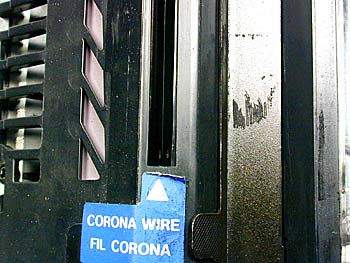
A strong lamp illuminates the original to be copied. A mirror is used to reflect light passing through a lens onto the drum. By adjusting the distance between the lens and the drum, the size of the original image can be reduced or magnified.
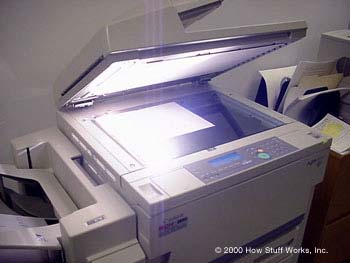
| How Things Work |
|---|
Why does the paper always hot when they come out of the photocopier?
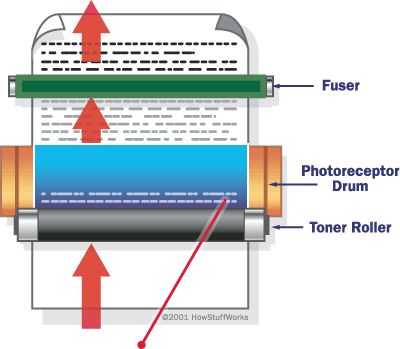 The
paper passes through the fuser which is a pair of heated rollers before coming
out from the photocopier. The heat will melt the toner powder and the
toner then fusing with the fiber of the paper. Finally, the finished
copy is rolled to the output tray. The temperature of the finished copy
will not be too hot because the speed of the paper rolling over the fuser is
very fast, otherwise, it will burn up due to the high temperature of the
fuser.
The
paper passes through the fuser which is a pair of heated rollers before coming
out from the photocopier. The heat will melt the toner powder and the
toner then fusing with the fiber of the paper. Finally, the finished
copy is rolled to the output tray. The temperature of the finished copy
will not be too hot because the speed of the paper rolling over the fuser is
very fast, otherwise, it will burn up due to the high temperature of the
fuser.
|
Printer |
|---|
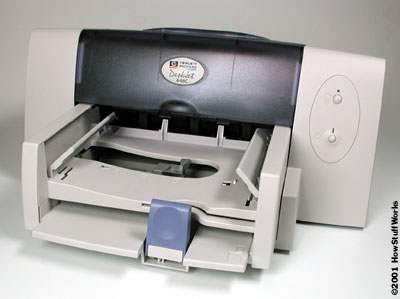
An inkjet printer is the printer that create image by placing extremely small droplets of ink onto paper. The dots are small, about 50-60 microns in diameter which is smaller than the diameter of human hair (70 microns). The resolution is about 1440 x 720 dots per inch (dpi). It may have different colors combining together to form a dot, creating photo-quality images. Inkjet printers have print head with 300 to 600 firing chambers which are tiny nozzles used to spray thousands of droplets of ink per second in a precise pattern to make up the text and images on a page. There are two types of inkjet technologies to squirt the ink droplets, thermal bubble printing technology and piezoelectric printing technology.
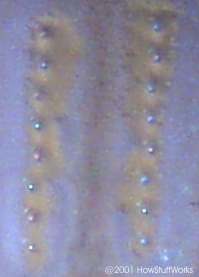
|
| View of the nozzles on a thermal bubble inkjet print head [i]. |
Thermal bubble printing
It uses heat to create a tiny bubble in the firing chamber forcing out an ink droplet.
| (courtesy How stuffs work) |
Each print head has many tiny nozzles that can fire ink droplets simultaneously.
| How Things Work | ||
|---|---|---|
| Bubble Jet Printing | ||
| 1. To push the ink through the nozzle, bubble jet printers heat minuscule quantities of ink by passing an electrical charge through a resistor through a resistor, which quickly reaches 900 degrees Fahrenheit. |
| |
| 2. The heating element vaporizes a tiny layer of ink at the bottom of the chamber for a few millionths of a second, forming a bubble, pushing the ink down the nozzle. |
| |
| 3. The bubble expands and forces a droplet of ink out of the nozzle. Colored droplets are generally so small that a quart could contain 100 billion such drops or more; black droplets are about four times as big. The whole process takes about 10 millionths of a second. The heating element cools and the bubble collapses, creating suction that draws more ink into the chamber from the ink cartridge. |
|
Piezoelectric printing
It uses a piezoelectric crystal, which bends when an electrical charge is applied to fire the ink drop onto the paper.
| (courtesy How stuffs work) |
| How Things Work | ||
|---|---|---|
| Piezoelectric Printing | ||
| 1. A piezoelectric printer works like a squirt gun, but instead of a trigger and plunger, it uses a piezoelectric crystal that changes shape when an electrical charge is applied. A small negative charge deflects the crystal away from the chamber, creating suction. |
| |
| 2. A positive charge bends the crystal in the other direction, which pushes a plate into the chamber to create the pressure to expel a droplet of ink. |
| |
| 3. An advantage to this approach is that the quantity of ink in the droplet can be precisely controlled. A small charge causes a slight deflection, enough to discharge as little as three-trillionths of a quart of ink through the nozzle. Larger charges can produce larger droplets. The ink is forced out through the nozzle. |
|
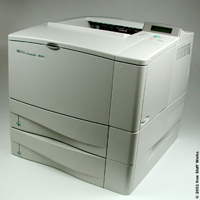
Laser printer
uses a laser beam to write letters or draw pictures on paper by sending data
from the computer. What is the scientific principles using in the laser
printing process? We will discuss this mystery in this section.
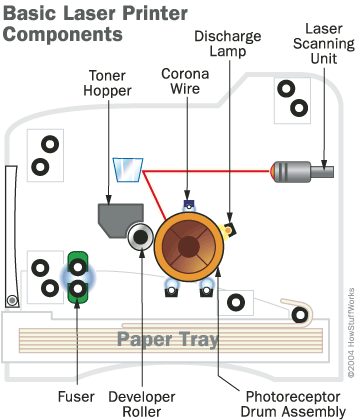
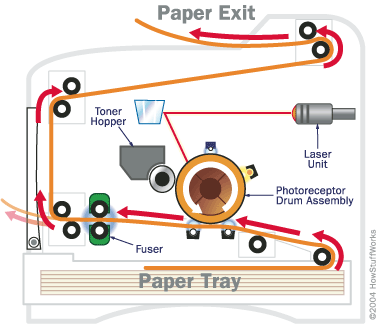
The principle
used in a laser printer is static electricity. Initially, the photoreceptor drum is
charged positively by corona wire by applying an electrical current on it.
Then the printer shines a tiny laser beam across the surface according to the data sent by the computer, one horizontal line at a time. The laser beam shines light on the drum for dot and light off for empty space on the page. The laser beam does not move itself but shines light through a movable mirror instead. The light discharge certain points on the photoreceptor drum and form an electrostatic image.
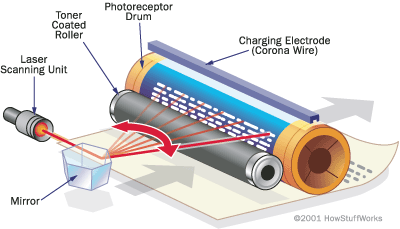 After
the pattern is set, the toner stored in a toner hopper is gathered by the developer
unit. The positively charged toner clings to the discharged areas of the
drum but not to the positively charged background (area with no light shine on).
After
the pattern is set, the toner stored in a toner hopper is gathered by the developer
unit. The positively charged toner clings to the discharged areas of the
drum but not to the positively charged background (area with no light shine on).
A sheet of
paper (with strong negative charges) is moving along the belt and rolls over the drum with affixed toner powder
pattern. The paper pulls the toner powder away from the drum and picks up
the image pattern fixed by the fuser. Then the finished copy is rolled to
the exit tray.
Comparison of laser printer with photocopier
Laser printers work the same basic way as photocopiers, with a few significant differences.
Medicine |
|---|
| How Things Work | |||||
|---|---|---|---|---|---|
|
| How Things Work | ||
|---|---|---|
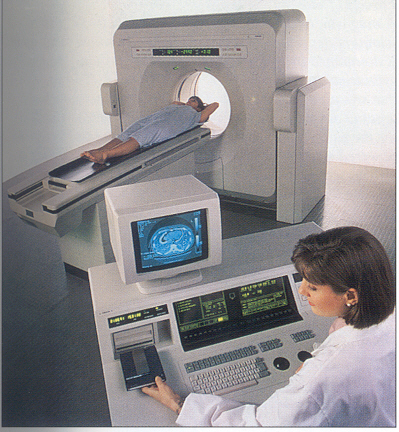 Computed tomography (CT) scan
is used to determine exactly where things are located inside a patient.
It can separate the superimposed internal structures of image obtained from
simple radiographs which are difficult to interpret. An X-ray beam is
passed through a thin slice of the body and is detected by a bank of detectors
as it emerges. The beam is then rotated around the subject, and another
exposure made until the same slice has been surveyed from all angles.
The scanner then shifts the patient's body to work on the next slice. A
computer reconstructs an image of the slice by mathematical method.
Many slices can be stacked on screen to form a three-dimensional view of a
patient's internal organs.
Computed tomography (CT) scan
is used to determine exactly where things are located inside a patient.
It can separate the superimposed internal structures of image obtained from
simple radiographs which are difficult to interpret. An X-ray beam is
passed through a thin slice of the body and is detected by a bank of detectors
as it emerges. The beam is then rotated around the subject, and another
exposure made until the same slice has been surveyed from all angles.
The scanner then shifts the patient's body to work on the next slice. A
computer reconstructs an image of the slice by mathematical method.
Many slices can be stacked on screen to form a three-dimensional view of a
patient's internal organs.
|
| How Things Work | |||
|---|---|---|---|
|
| How Things Work | |||
|---|---|---|---|
Ultrasound scan can also be used to detect tumors or fluid-filled cysts. Relatively large echoes are sent back from organ boundaries, while small structures within the tissue give "grainy" low-level echoes which can be distinguished from healthy tissue. |
Maglev Trains |
|---|
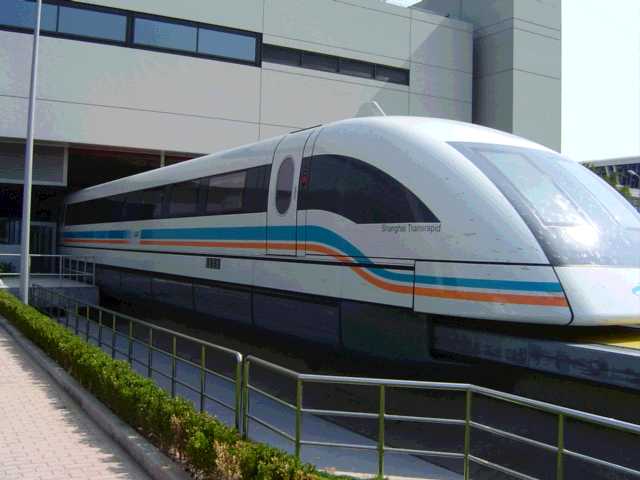
|
| A Maglev in Shanghai |
Maglev train, short for magnetic levitation train, is a new form of transport mode that enhances the speed of carrying passengers from one end to another. It uses the basic principles of magnets floating over a guideway to replace the old steel wheel and track that is a breakthrough of the limitations of friction between the train wheels and its rails.
| Basic knowledges of Magnetic fields |
| A bar magnet has two poles, called the north pole and the south pole. Magnetic field leaves the magnet from the north pole and goes to the magnet again at the south poles. This magnetic field forms closed lines as presented in the diagram of the bar magnet. |
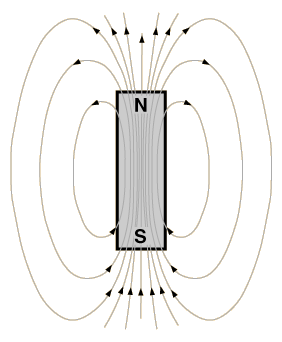
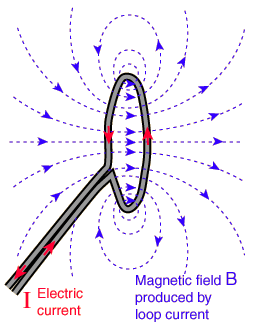 |
| Other than the permanent magnet, magnetic field can be produced by moving electric charge called electric current. When electric current flows through a loop of wire, magnetic field is so produced, as shown in the above figure. |
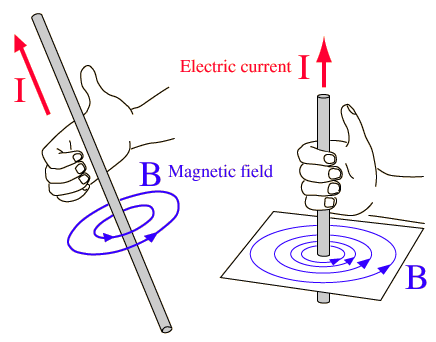 Consider a current in a wire, the direction of the magnetic field is perpendicular to the electric
field. The lines of the magnetic field form concentric circles around
the wire. Right hand rule
can express this direction relationship. The direction of the magnetic
field is perpendicular to the wire and is in the curling direction of your
right hand fingers. The direction of your thumb is the direction of
electric current.
Consider a current in a wire, the direction of the magnetic field is perpendicular to the electric
field. The lines of the magnetic field form concentric circles around
the wire. Right hand rule
can express this direction relationship. The direction of the magnetic
field is perpendicular to the wire and is in the curling direction of your
right hand fingers. The direction of your thumb is the direction of
electric current.
|
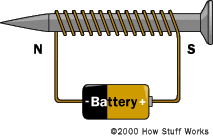 An electromagnet can be obtained in the following way. You can wrap the wire around a nail several times,
the nail behaves just like a bar magnet when current runs through the circuit.
Putting iron or other magnetic material inside the coil can make the
electromagnet even stronger. Besides, increasing the number of turns
of wire wrapping can also enhance the magnetic field generated.
An electromagnet can be obtained in the following way. You can wrap the wire around a nail several times,
the nail behaves just like a bar magnet when current runs through the circuit.
Putting iron or other magnetic material inside the coil can make the
electromagnet even stronger. Besides, increasing the number of turns
of wire wrapping can also enhance the magnetic field generated.
|
| Electromagnetic induction |
| A changing magnetic field creates an electric field which pushes on the conductor's mobile electric charges to move and form an electric current. This process is called electromagnetic induction. |
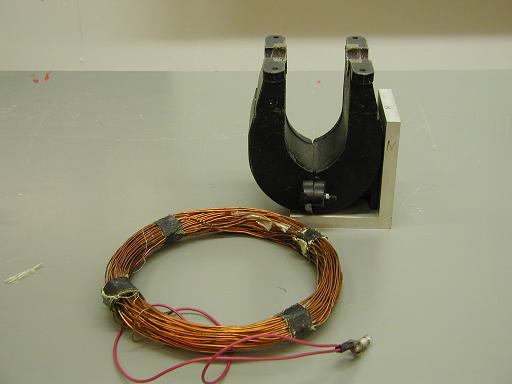 Demonstration of electromagnetic induction [iii] |
| In the above demonstration, a small light bulb is connected to a large coil of wire. The coil is moved in and out of a magnet. This changing magnetic field induces an electric current. The bulb lights as the current passing through the circuit. In fact, the current runs in a direction such that a magnetic field is created to oppose the change. This is the Lenz's law. |
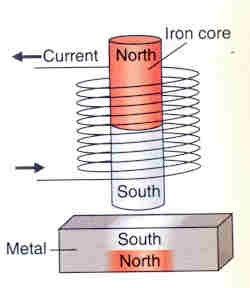
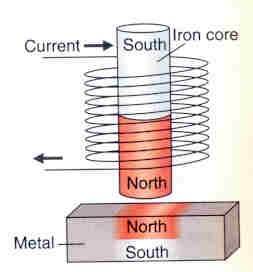
|
|
When an alternating
current is flowing through a coil of wire wrapping around an iron
core, the poles of the electromagnet is reversed by changing the direction of
electric current flowing. If an electric conductor (the metal bar in the
above figure) is placed near the
electromagnet, the magnetic field is so induced on the metal bar to
oppose the changing magnetic field above it. It is, of course, due to the induced alternating current
in the metal bar. Simply, a changing magnetic field in the iron core turns an electric
conductor nearby into a magnet. For example, if the south pole of the electromagnet is near the conductor, then the conductor becomes magnetic with its south pole up pointing towards the electromagnet to repel it. When the current now reverses the direction changing the pole direction with north pole down, the conductor becomes magnetic with its north pole up to repel the electromagnet. The currents generated by electromagnetic induction always produce magnetic fields that oppose the magnetic field change. |
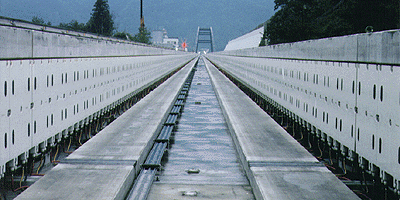
|
| Image of the guideway for the Yamanashi maglev test line in Japan [iii] |
Maglev train rides above the track by magnetic suspension instead of rolling on wheels conventionally. The working principles are as follows. [iv]
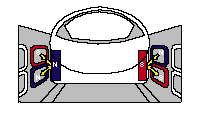 The "8" figured levitation coils are installed on the sidewalls of the guideway.
When the on-board superconducting magnets pass at a high speed about several
centimeters below the center of these coils, an electric current is induced within
the coils, which then act as electromagnets temporarily. As a result, there are
forces which push the superconducting magnet upwards and ones which pull them upwards
simultaneously, thereby levitating the Maglev vehicle.
The "8" figured levitation coils are installed on the sidewalls of the guideway.
When the on-board superconducting magnets pass at a high speed about several
centimeters below the center of these coils, an electric current is induced within
the coils, which then act as electromagnets temporarily. As a result, there are
forces which push the superconducting magnet upwards and ones which pull them upwards
simultaneously, thereby levitating the Maglev vehicle.
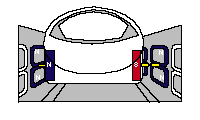 The levitation coils facing each other are connected
under the guideway, constituting a loop. When a running Maglev vehicle,
that is a superconducting magnet, displaces laterally, an electric current
is induced in the loop, resulting in a repulsive force acting on the levitation
coils of the side near the car and an attractive force acting on the levitation
coils of the side farther apart from the car. Thus, a running car is always
located at the center of the guideway.
The levitation coils facing each other are connected
under the guideway, constituting a loop. When a running Maglev vehicle,
that is a superconducting magnet, displaces laterally, an electric current
is induced in the loop, resulting in a repulsive force acting on the levitation
coils of the side near the car and an attractive force acting on the levitation
coils of the side farther apart from the car. Thus, a running car is always
located at the center of the guideway.
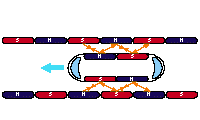 A repulsive force and an attractive force induced between the magnets
are used to propel the vehicle (superconducting magnet). The propulsion
coils located on the sidewalls on both sides of the guideway are energized
by a three-phase alternating current from a substation, creating a shifting
magnetic field on the guideway. The on-board superconducting magnets are
attracted and pushed by the shifting field, propelling the Maglev vehicle.
A repulsive force and an attractive force induced between the magnets
are used to propel the vehicle (superconducting magnet). The propulsion
coils located on the sidewalls on both sides of the guideway are energized
by a three-phase alternating current from a substation, creating a shifting
magnetic field on the guideway. The on-board superconducting magnets are
attracted and pushed by the shifting field, propelling the Maglev vehicle.
However, the ordinary permanent magnet is
heavy and expensive, so most electrodynamics levitation schemes use
electromagnets instead. They use special wires made of
superconductors that
the currents flow perfectly
and freely while currents flowing in metal experience frictionlike effects and
gradually slow down. Superconductor can behave like a light and
superstrong permanent magnet at low temperature. A maglev train using
superconducting magnets must be kept cold to make them magnetic and can hover
easily without requiring much electric power.